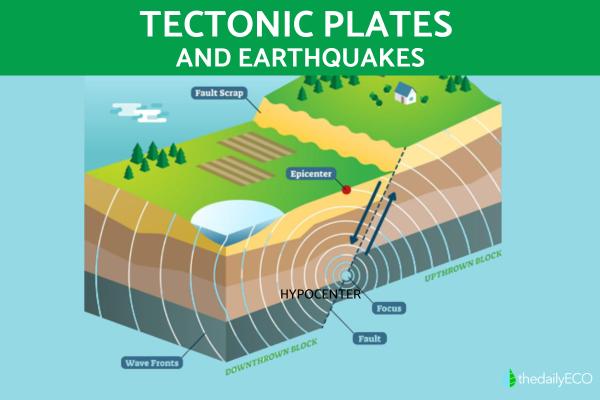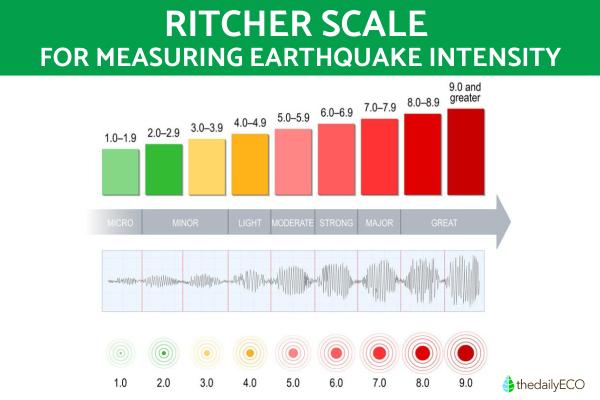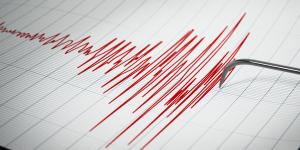What Is an Earthquake and How Does It Occur?


Earthquakes have the power to shake the very core of our planet. Astonishingly, close to half a million earthquakes take place each year, with most passing by unnoticed, their magnitudes detectable solely by seismometers. But what truly defines an earthquake? Our fascination with these enigmatic natural events stems from their inherent danger and unpredictability.
The following article, thedailyECO, explores what an earthquake is and their classification, discusses measurement methods, and confronts the often devastating aftermaths they leave in their wake.
What is an earthquake?
An earthquake is a natural phenomenon that occurs when there is a sudden and violent shaking or trembling of the Earth's surface. This shaking is caused by the release of energy that has built up within the Earth. When this energy is released, it generates seismic waves, which are waves of energy that travel through the Earth's crust and cause the ground to shake.
When classifying earthquakes, scientists often consider various factors, including their origin, magnitude, and shape. However, regardless of their specific characteristics, all earthquakes share a common trait – their transient nature.
Earthquakes can vary in size and intensity, from minor tremors that are barely felt to powerful quakes that can cause significant damage to buildings, infrastructure, and the environment.
To gain a deeper understanding of earthquakes, it's crucial to grasp certain key concepts associated with their origin. On one hand, we have the hypocenter, which is the exact spot beneath the Earth's surface where an earthquake originates. It's where seismic energy is initially released.
In contrast, the epicenter is the point directly above the hypocenter on the Earth's surface. When people talk about an earthquake's location, they're usually referring to the epicenter, as it's where the strongest shaking is felt.

How do earthquakes usually occur?
Earthquakes primarily originate due to tectonic activity. This phenomenon is rooted in the concept that the Earth's outermost layer, known as the lithosphere, is composed of massive tectonic plates that constantly move. These plates can either slide past one another, pull apart, or collide. It is these dynamic interactions between tectonic plates that give rise to most earthquakes.
Tectonic activity is driven by the movement of the Earth's lithospheric plates. These plates are like enormous puzzle pieces, covering the Earth's surface. As they shift and interact, they generate immense geological forces and stresses. When the accumulated stress along plate boundaries exceeds the strength of the rocks holding them in place, it results in a sudden release of energy. This release of energy is what triggers an earthquake.
While tectonic activity is the primary driver of earthquakes, there are various other factors and causes that can lead to seismic events. These diverse triggers give rise to a comprehensive classification of earthquakes, which we'll explore further in the following section.
Learn about the difference between earthquake and tremor in our other article.
Types of earthquakes
Earthquakes can be categorized into two main groups: natural causes and anthropogenic (human-induced) causes. Additionally, they can be further classified into various types based on a range of factors, including their underlying causes and unique characteristics. To gain a deeper understanding, let's explore the distinct types of earthquakes that fall within these categories:
Earthquakes due to natural causes
- Tectonic earthquakes: these are the most common type of earthquakes and are associated with the movement of tectonic plates. They typically occur at the boundaries between different tectonic plates or, less frequently, within the plates themselves. The stress and energy built up along these plate boundaries are released in the form of seismic waves, causing earthquakes.
- Volcanic earthquakes: these earthquakes are generated by the fragmentation of rock due to volcanic activity in a region. The movement of magma beneath the Earth's surface and the associated pressure changes can lead to seismic events.
- Collapse earthquakes: these earthquakes are associated with sudden movements of rock or earth masses. For example, they can occur when there's a rapid slide down a slope, leading to the ground shaking as a result of the mass movement.
- Earthquakes due to meteorite impacts: while rare on Earth, some earthquakes in history have been caused by the violent shaking that occurs when a meteorite impacts the ground.
Earthquakes due to anthropogenic causes
- Earthquakes induced by large reservoirs: these earthquakes are triggered by the weight of water in large reservoirs and the sudden changes that occur when water is released. The pressure from the water can induce seismic activity.
- Earthquakes due to nuclear explosions or mines and quarries: nuclear explosions, such as those from underground nuclear tests, can produce earthquakes of moderate magnitude. Similarly, explosions in mines and quarries can generate seismic events, typically of lower magnitude.
- Earthquakes induced by oil extraction: hydraulic fracturing, also known as fracking, is a technique used for gas and oil extraction. It can lead to the creation of microearthquakes, and occasionally, larger earthquakes, as the process involves breaking the ground to access hydrocarbons.
With this understanding of earthquake classification, let's now explore how earthquakes are measured to assess their magnitude and intensity.
How are earthquakes measured?
Earthquakes are measured using a system called seismic magnitude scales. The most commonly used scale is the Richter scale, but there are others such as the moment magnitude scale (Mw) that provide more accurate measurements for larger earthquakes. Let us take a closer look at how each of these methods work:
The Richter scale is a logarithmic scale used to quantify the magnitude of an earthquake. It calculates the magnitude based on the seismic waves' amplitude and the distance from the earthquake's epicenter. This scale is effective for measuring earthquakes with magnitudes ranging from 2 to 6.9 and depths from 0 to 400 kilometers below the Earth's surface.
While the Richter scale has been a valuable tool for assessing seismic events, another scale called the seismological moment magnitude scale (Mw) is also frequently used, especially for larger earthquakes. This method has gained popularity in recent years because it provides a more precise measurement for earthquakes with magnitudes greater than 6.9.
It takes into account not only the amplitude of seismic waves but also factors such as the stiffness of the rock and the average distance of displacement along the fault. This comprehensive approach allows for a more accurate assessment of the earthquake's size and energy release.
Be sure to read this other article that explores how are mountains created.

Consequences of earthquakes
Earthquakes can have a wide range of consequences, and their impact can vary depending on factors such as the earthquake's magnitude, depth, distance from populated areas, and the local geological and structural conditions. Here are some of the common consequences of earthquakes:
- Structural damage: earthquakes can cause significant damage to buildings, bridges, roads, and other infrastructure. This damage can lead to collapses, making it dangerous for people to be inside or near affected structures.
- Injuries and loss of life: the physical force of an earthquake, along with falling debris and collapsing structures, can result in injuries and fatalities. The extent of casualties often depends on the earthquake's magnitude and the preparedness of the affected area.
- Tsunamis: underwater earthquakes, especially those occurring along tectonic plate boundaries, can trigger tsunamis. These massive ocean waves can inundate coastal areas, causing widespread destruction and loss of life.
- Landslides: earthquakes can destabilize slopes and trigger landslides, which can bury homes, roads, and communities. This is particularly common in hilly or mountainous regions.
- Fire: gas lines can rupture during an earthquake, leading to fires that can spread rapidly in urban areas where buildings are closely spaced. Controlling these fires can be difficult during the chaos of an earthquake.
- Economic impact: the damage to infrastructure, businesses, and homes can have a significant economic impact on affected regions. Rebuilding and recovery efforts often require substantial financial resources.
- Environmental effects: earthquakes can alter landscapes, change river courses, and affect groundwater. They may also release toxins from underground sources, posing environmental challenges.
- Displacement: people may be forced to leave their homes due to earthquake damage or the risk of further seismic activity. This displacement can lead to temporary or long-term housing challenges.
It's important to note that earthquake preparedness, early warning systems, and effective emergency response measures can mitigate some of these consequences and reduce the overall impact of earthquakes on communities and regions.
To gain a better understanding of various geological processes, such as volcanoes, delve into our article that explains the causes behind a volcano's eruption.
If you want to read similar articles to What Is an Earthquake and How Does It Occur?, we recommend you visit our Facts about nature category.
- Sánchez, FV (1994). Earthquakes and their causes. In The study of earthquakes in Almería (pp. 17-38). Institute of Almeria Studies.







